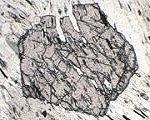Practical Aspects of Mineral Thermobarometry
Mode calculations in THERMOCALC
THERMOCALC's modal amounts
All THERMOCALC's calculations are done in moles and molar percentages of the oxide system components. So, the essential pieces of knowledge for decoding their meaning are
- which oxides are being accounted for. For example in KFMASH with muscovite and quartz in excess, the oxides components are Al2O3, MgO, FeO, K2O.
- the total number of moles of these oxides in the formula unit of each end member or phase. For example garnet (pyrope) 3MgO + Al2O3 = 4, biotite (phlogopite) 0.5K2O + 3MgO + 0.5Al2O3 = 4.
THERMOCALC’s "modes" might be more appropriately called oxide-molar proportions, since the "mode" of a particular phase is the proportion of the total number of moles of the oxides under consideration which are combined in that phase. The relationship with the volume proportions is not all that simple:
- Not all end members of the same phase contain the same number of moles of oxides: consider diopside (CaO + MgO + 2SiO2 = 4) and Ca-tschermak's pyroxene (CaO + Al2O3 + SiO2 = 3).
- Consider doing two sets of calculations at the same P and T, but in one case considering quartz in excess, and in the other not in excess. In the first case SiO2 is not considered, so garnet contains 4 oxide moles, and albite only 1 (0.5 Na2O + 0.5 Al2O3 ). In the second case, with SiO2 included, garnet contains 7 oxide moles and albite 4. The molar amounts of the phases garnet and feldspar are the same in both cases, and thus so are their relative volumes, but their calculated "modes" will appear to be different!
Converting "modes" to volume proportions
- Divide by the number of moles of oxides per formula unit, to get the number of moles of each phase. In difficult cases, such as where not all end members contain the same number of moles of oxides, you will need to consider the calculated composition of the phase, and the divisor will not be a whole number.
- Estimate the molar volume of the phase, using the calculated phase composition and interpolating between the molar volumes of the end members if necessary.
- Multiply the molar volume by the number of moles of the phase, to get relative volume proportions, and normalise them to 100% for volume percentages.
Note that the volume percentages will not necessarily include all the phases in the rock. For calculations in KFMASH projected from muscovite and quartz, muscovite is included in the modes, but quartz is not. Before comparing with real rocks, the volume percentages will need to be re-normalised to take account of the quartz content of the natural samples, plus the volume of any other phases which are not included in the model system.
This page last modified 12 October 2004
